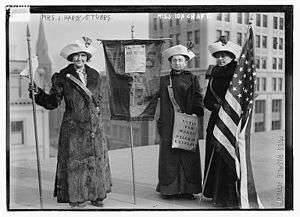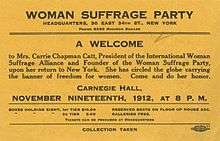Woman Suffrage Party
| Abbreviation | WSP |
|---|---|
| Successor | League of Women Voters, New York chapter |
| Formation | 1909 |
| Founder | Carrie Chapman Catt |
| Extinction | 1919 |
| Purpose | Women's suffrage in New York and the US |
The Woman Suffrage Party (WSP) was a New York city political organization dedicated to women's suffrage. It was founded in New York by Carrie Chapman Catt at the Convention of Disfranchised Women in 1909.[1] WSP called itself "a political union of existing equal suffrage organizations in the City of New York."[2] WSP was many New York women's first experience with politics and "contributed directly to the passage of a woman suffrage amendment in New York state."[3]
History

Carrie Chapman Catt organized the WSP like a "political machine."[4] The bottom level of the group included individual party members, who then chose district leaders who would represent them at borough and city conventions. The top level of WSP was a board of all of the district chairs.[5] In total, there were 804 delegates and 200 alternates, making the WSP the "largest delegate suffrage body ever assembled in New York State."[6]
In order to raise money for the group, WSP took in contributions from individuals, sponsored benefits and also created several "fund-raising stunts."[7] These included "self-denial week" where members saved money by eating ten-cent sandwiches, walked instead of hiring cabs, and forwarded the savings to the WSP. "Sacrifice Day" on August 7, 1914, saw women attending a luncheon where they donated jewelry and watches to further the cause.[7] WSP did not use violent tactics to achieve their goals.[8]
Women in the WSP raised awareness by organizing large meetings, passing out suffrage-related literature and marched in parades.[7] Parades included black women as well as white women, though in one parade on May 4, 1912, a black girl was mistreated by a group of men until "the division marshal beat them off with a flagpole."[9] Members also went door to door throughout New York, spreading the word and encouraging men to sign petitions for women's right to vote.[7] WSP also steadily applied pressure to "New York political machines to accept women's demands."[10]
WSP was inclusive and "actively recruited working-class women."[11] The organization was very interested in ensuring that women were paid fair wages in factories and that women had a say in government regulation of large industries.[12] The WSP also advocated that women be paid the same as men for the same work.[12] WSP also printed much of their literature in other languages, in order to reach minority groups, such as Italian, Jewish and Chinese women in New York.[13] WSP also reached out to Catholic women by printing literature with testimonials from sympathetic Catholic clergy and also by joining with the St. Catherine's Welfare Society, which was pro-suffrage.[14] While WSP did recruit working-class women and minorities, many members of WSP were firmly socially conservative and did not want to mix with the poor or with minorities.[15]

By 1915, the WSP had a hundred thousand members.[16] During the summer of 1915, the WSP ran a "model woman suffrage campaign," with 5,225 outdoor meetings, 13 concerts and 28 parades and processions.[17] Members continued to reach out door to door and by telephone. WSP sponsored a boat to run between Coney Island and Brighton Beach with a ten-foot sign urging people to support women's suffrage.[17] When the vote for suffrage was not in their favor in November 1915, the WSP continued to lobby for another referendum for women's voting rights.[18] By November 6, 1917, there was a resounding win for women's suffrage in New York. Catt called the New York campaign the "decisive battle of the American woman suffrage movement."[19]
After women earned the right to vote in New York, the WSP helped women prepare to exercise their rights.[20] Two committees were formed to help women prepare to vote: The Americanization Committee, under the direction of Mary E. Dreier, and the Women Voters' Council, under the leadership of Hay, which educated American voters.[20] The Americanization Committee taught English classes to women who were born outside of the United States.[20] They also visited tenements, aided in helping women achieve citizenship, and saw to educating entire families.[21] The educational efforts of the WSP were completely non-partisan.[21]
The WSP continued to lobby in the federal suffrage campaign until May 1919, when the WSP became the New York chapter of the League of Women Voters.[22]
WSP published The Woman Voter as their official journal[23] until 1917 when it merged with other publications to form The Woman Citizen.
Notable members
Many members of WSP were notable women in the fight for women's suffrage. Mary Ritter Beard was the vice-chair of the Manhattan branch of the WSP in 1910.[24] She left that post at about the same time she quit editing the official journal of WSP, The Woman Voter, in 1912.[25] In 1915, Mary Garret Hay was the president.[16] In 1917, Helen Rogers Reid became the treasurer of the WSP.[26] Vira Boarman Whitehouse was the head of the WSP in 1917 when women were given the right to vote in New York.[27]
References
Citations
- ↑ Endres 1996, p. 454.
- ↑ "Miller NAWSA Suffrage Scrapbooks, 1897-1911". The Library of Congress. Retrieved 10 March 2016.
- ↑ Schaffer 1962, p. 269.
- ↑ Van Voris 1987, p. 79.
- ↑ Schaffer 1962, p. 270.
- ↑ Buhle and Buhle 2005, p. 401.
- 1 2 3 4 Schaffer 1962, p. 271.
- ↑ Vapnek 2009, p. 138.
- ↑ Schaffer 1962, p. 272.
- ↑ Buhle and Buhle 2005, p. 34.
- ↑ Vapnek 2009, p. 132.
- 1 2 Schaffer 1962, p. 273.
- ↑ Schaffer 1962, p. 275.
- ↑ Schaffer 1962, p. 277.
- ↑ "Working Class Dirt, Smell, and Sweat: Sanger and the Women's Suffrage Party". Margaret Sanger Papers Project. 19 August 2015. Retrieved 12 March 2016.
- 1 2 Van Voris 1987, p. 118.
- 1 2 Schaffer 1962, p. 280.
- ↑ Schaffer 1962, p. 282.
- ↑ Schaffer 1962, p. 283.
- 1 2 3 Vogue 1917, p. 52.
- 1 2 Vogue 1917, p. 96.
- ↑ Schaffer 1962, p. 284.
- ↑ Leonard 1914, p. 902.
- ↑ Lane 1977, p. 75-76.
- ↑ Leonard 1914, p. 87.
- ↑ Van Voris 1987, p. 143.
- ↑ Dismore, David (7 November 2014). "Today in Herstory: Suffrage Leaders Celebrate Victory in New York". Feminist Majority Foundation Blog. Retrieved 10 March 2016.
Sources
- Buhle, Mari Jo; Buhle, Paul, eds. (2005). The Concise History of Woman Suffrage: Selections from History of Woman Suffrage, by Elizabeth Cady Stanton, Susan B. Anthony, Matilda Joslyn Gage, and the National American Woman Suffrage Association. Chicago: University of Illinois Press. ISBN 9780252072765.
- Endres, Kathleen (1996). "The Woman Voter". In Endres, Kathleen L.; Lueck, Therese L. Women's Periodicals in the United States: Social and Political Issues. Westport, Connecticut: Greenwood Press. ISBN 9780313286322.
- Lane, Ann J.; Beard, Mary Ritter (1977). Making Women's History: The Essential Mary Ritter Beard. New York: The Feminist Press at the City University of New York. ISBN 9781558612198.
- Leonard, John William (1914). Woman's Who's Who of America: A Biographical Dictionary of Contemporary Women of the United States and Canada. New York: The American Commonwealth Company. ISBN 9780810340183.
- Schaffer, Ronald (July 1962). "The New York City Woman Suffrage Party, 1909-1919". New York State Historical Association. 43 (3): 269–287. JSTOR 23153512. (subscription required (help)).
- Vapnek, Lara (2009). Breadwinners: Working Women and Economic Independence, 1865-1920. Urbana, Illinois: University of Illinois Press. ISBN 9780252034718.
- Van Voris, Jacqueline (1987). Carrie Chapman Catt: A Public Life. New York: The Feminist Press at The City University of New York. ISBN 9781558611399.
- "The School For Voters". Vogue: 52, 96–97. 15 September 1917. Retrieved 11 March 2016.
External links
- Woman Suffrage Party statement
- The German Woman and Modern Problems (10 February 1915)
- New York State Woman Suffrage Party Petitions (1917)